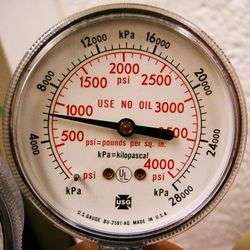Pounds per square inch

The pound per square inch or, more accurately, pound-force per square inch (symbol: lbf/in2;[1] abbreviations: psi, lbf/sq in, lbf/sq in) is a unit of pressure or of stress based on avoirdupois units. It is the pressure resulting from a force of one pound-force applied to an area of one square inch:
1 psi = ≈ ≈ 6894.757 N/m²
Therefore, one pound per square inch is approximately 6894.757 Pa.
Now converting the psi to standard atmospheres:
1 atm = = ≈ 14.70 lbf/in2
Therefore, 1 atmosphere is approximately 14.7 pounds per square inch.
Pounds per square inch absolute (psia) is used to make it clear that the pressure is relative to a vacuum rather than the ambient atmospheric pressure. Since atmospheric pressure at sea level is around 14.7 psi, this will be added to any pressure reading made in air at sea level. The converse is pounds per square inch gauge or pounds per square inch gage (psig), indicating that the pressure is relative to atmospheric pressure. For example, a bicycle tire pumped up to 65 psi above local atmospheric pressure (say, 14.7 psia locally), will have a pressure of 65 + 14.7 = 79.7 psia or 65 psig.[2][3] When gauge pressure is referenced to something other than ambient atmospheric pressure, then the units would be pounds per square inch differential (psid).
Multiples
The kilopound per square inch (ksi) is a scaled unit derived from psi, equivalent to a thousand psi (1000 lbf/in2).
Ksi are not widely used for gas pressures. They are mostly used in materials science, where the tensile strength of a material is measured as a large number of psi.[4]
The conversion in SI Units is 1 ksi = 6.895 MPa, or 1 MPa = 0.145 ksi.
The megapound per square inch (Mpsi) is another multiple equal to a million psi. It is used in mechanics for the elastic modulus of the materials, especially for metals.[5]
The conversion in SI Units is 1 Mpsi = 6.895 GPa, or 1 GPa = 0.145 Mpsi.
Magnitude
- Inch of water: 0.036 psid
- Blood pressure – clinically normal human blood pressure (120/80 mmHg): 2.32 psig/1.55 psig
- Natural gas residential piped in for consumer appliance; 4–6 psig.
- Boost pressure provided by an automotive turbocharger (common): 6–15 psig
- NFL football: 12.5–13.5 psig
- Atmospheric pressure at sea level (standard): 14.7 psia
- Automobile tire overpressure (common): 32 psig
- Bicycle tire overpressure (common): 65 psig
- Workshop or garage air tools: 90 psig
- Air brake (rail) or air brake (road vehicle) reservoir overpressure (common): 90–120 psig
- Road racing bicycle tire overpressure: 120 psig
- Steam locomotive fire tube boiler (UK, 20th century): 150–280 psig
- Union Pacific Big Boy steam locomotive boiler: 300 psig
- Natural gas pipelines: 800–1000 psig
- Full SCBA (self-contained breathing apparatus) for IDLH (non-fire) atmospheres: 2216 psig
- Full SCUBA (self-contained underwater breathing apparatus) tank overpressure (common): 3000 psig
- Full SCBA (self-contained breathing apparatus) for interior firefighting operations: 4500 psig
- Airbus A380 hydraulic system: 5000 psig
- Ultimate strength of ASTM A36 steel: 58,000 psi
- Water jet cutter: 40,000–100,000 psig
Conversions
| Pascal | Bar | Technical atmosphere | Standard atmosphere | Torr | Pounds per square inch | |
|---|---|---|---|---|---|---|
| (Pa) | (bar) | (at) | (atm) | (Torr) | (psi) | |
| 1 Pa | ≡ 1 N/m2 | 10−5 | 1.0197×10−5 | 9.8692×10−6 | 7.5006×10−3 | 1.450377×10−4 |
| 1 bar | 105 | ≡ 100 kPa
≡ 106 dyn/cm2 |
1.0197 | 0.98692 | 750.06 | 14.50377 |
| 1 at | 9.80665×104 | 0.980665 | ≡ 1 kp/cm2 | 0.9678411 | 735.5592 | 14.22334 |
| 1 atm | 1.01325×105 | 1.01325 | 1.0332 | 1 | ≡ 760 | 14.69595 |
| 1 Torr | 133.3224 | 1.333224×10−3 | 1.359551×10−3 | ≡ 1/760 ≈ 1.315789×10−3 | ≡ 1 Torr
≈ 1 mmHg |
1.933678×10−2 |
| 1 psi | 6.8948×103 | 6.8948×10−2 | 7.03069×10−2 | 6.8046×10−2 | 51.71493 | ≡ 1 lbF /in2 |
See also
References
- ↑ IEEE Standard Letter Symbols for Units of Measurement (SI Units, Customary Inch-Pound Units, and Certain Other Units), IEEE Std 260.1™-2004 (Revision of IEEE Std 260.1-1993)
- ↑ "Glossary of Industrial Air Cleaning Technology". United Air Specialists, Inc. Archived from the original on August 1, 2011.
- ↑ "Gage v. Sealed v. Absolute pressure" (PDF). Dynisco.
- ↑ "Tensile Strength of Steel and Other Metals". All Metals & Forge Group. Retrieved 2016-07-26.
A metal’s yield strength and ultimate tensile strength values are expressed in tons per square inch, pounds per square inch or thousand pounds (KSI) per square inch. For example, a tensile strength of a steel that can withstand 40,000 pounds of force per square inch may be expressed as 40,000 PSI or 40 KSI (with K being the [multiplier] for thousands of pounds). The tensile strength of steel may also be shown in MPa, or megapascal.
- ↑ An example of the use of Mpsi in mechanics for the elastic moduli of several materials